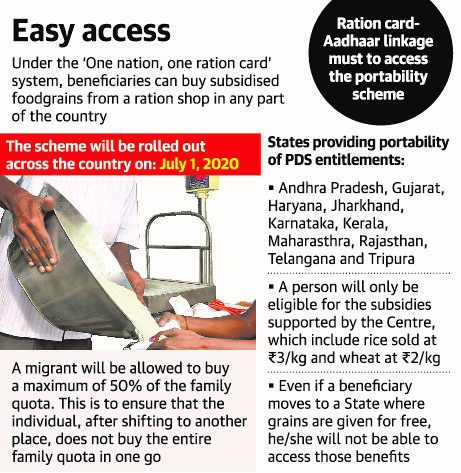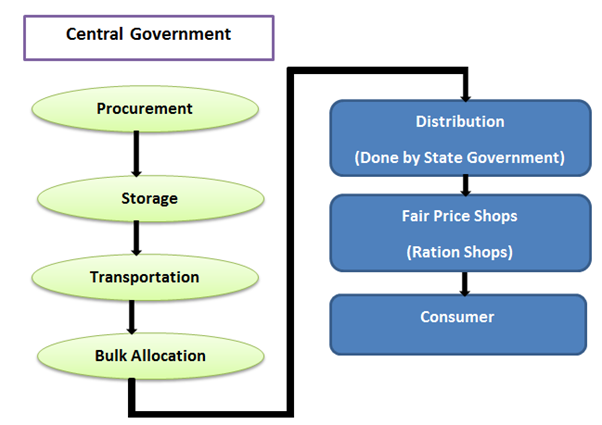PREVIOUS
ONE NATION - ONE RATION CARD
The story so far
-
The Union Ministry of Consumer Affairs, Food and Public Distribution recently announced that the One Nation, One Ration Card (ONORC) scheme would be introduced from July 1, 2020.
-
The scheme seeks to facilitate portability of subsidised food grains for internal migrant workers, provided their ration card is digitalized and linked with Aadhar.
-
According to Union Minister of Consumer Affairs, Ram Vilas Paswan, intra-state access to the Public Distribution System (PDS) under the Integrated Management of Public Distribution System (IMPDS), an online database of ration cards, is already in practice in a few states.
History
- The food rationing and PDS system was begun during the famine of 1940, and was revived in 1970 as a universal food entitlement programme for Indian citizens.
- In 1997, the universal food scheme was made a targeted one, covering poor and vulnerable people.
- Later, in 2013, due to civil society and judicial influence, the landmark National Food Security Act (NFSA) was passed by Parliament.
- It made the right to food a legal entitlement for two-thirds of poor households in India.
National Food Security Act
- The basic concept of food security globally is to ensure that all people, at all times, should get access to the basic food for their active and healthy life and is characterized by availability, access, utilization and stability of food
- Food security can also be derived from the fundamental right to life enshrined in Article 21 of the Constitution.
- So, it can be interpreted to include right to live with human dignity, which may include the right to food and other basic necessities.
- In pursuance of this, the enactment of the National Food Security Act, (NFSA) 2013 marks a paradigm shift in the approach to food security from welfare to the rights-based approach.
- The Act legally entitles up to 75% of the rural population and 50% of the urban population to receive subsidized food grains under the Targeted Public Distribution System.
About the Scheme
- One Nation, One Ration Card will bring noticeable changes in the lives of vulnerable migrant workers in India.
- It seeks to provide portability of food security benefits all across the nation.
- One Nation One Ration Card will ensure all beneficiaries especially migrants can access PDS across the nation from any PDS shop of their own choice.

- No poor person is deprived of getting subsidized food grains under the food security scheme when they shift from one place to another.
- It also aims to remove the chance of anyone holding more than one ration card to avail benefits from different states.
Features
- The poor migrant workers will be able to buy subsidised rice and wheat from any ration shop in the country but for that their ration cards must be linked to Aadhaar.
- Migrants would only be eligible for the subsidies supported by the Centre, which include rice sold at Rs. 3/kg and wheat at Rs. 2/kg.
- It would not include subsidies given by their respective state government in some other state.
- The system will also help to remove fake ration card holders.
- The scheme can be implemented as already 77% of the ration shops across the country have Point of Sale (PoS) machines and more than 85% of people covered under the National Food Security Act (NFSA) have linked their cards with Aadhaar.
- For remaining beneficiaries, all the States have been given one more year to use Point of Sale (PoS) machines in the ration shops and implement the scheme.
Public Distribution System (PDS) - Significance
- To see the benefits of ONORC, it is important to understand the functioning of the PDS across the value chain.
- Two processes central to the PDS are:
- Identification of beneficiaries,
- Due allocation as per the attributes (price, quantity), besides meeting the requirement of the quality and variety of grains.

- The work done by the PDS fair price shops is a lifeline for 81 crore beneficiaries across the country.
- There are 612 lakh tonnes of food grains stored in warehouses of FCI, warehouses of centre and states, and private godown for distribution annually.
- Around 78 per cent of Fair Price Shops in India have so far been automated by installing electronic PoS devices.
Plan
- The ‘One Nation, One Ration Card’ will mostly assist seasonal and circular migrant workers to have better access to PDS, both, at source and destination.
- The authorities can be expected to encounter hard-hitting ground realities for designing and implementing the scheme.
- The Centre hopes that allowing ration card portability will also curb corruption and improve access and service quality by removing monopolies.
- Under the old system, beneficiaries were dependent on a single fair price shop and subject to the whims of its dealer.
- Under the new system, if they are denied service or face corruption or poor quality in one shop, they are free to head to a different shop.
- The scheme is also driving the faster implementation of initiatives to digitise and integrate the food storage and public distribution system.
- The scheme involves the creation of a central repository of NFSA beneficiaries and ration cards, which will integrate the existing databases maintained by States, Union Territories and the Centre.
- Aadhaar seeding is also important as the unique biometric ID will be used to authenticate and track the usage of ration by beneficiaries anywhere in the country.
- Currently, it is estimated that around 85% of ration cards are linked to Aadhaar numbers.
- For the scheme to work, it is critical that all fair price shops are equipped with electronic point-of-sale machines (ePoS), replacing the old method of manual record-keeping of transactions with a digital real-time record.
- On the back-end, the Food Corporation of India’s Depot Online System is integrating all warehouses and godown storing subsidised grain in an attempt to create a seamless flow of online information from procurement until distribution.
Implementation
- The Ministry of Consumer Affairs, Food and Public Distribution will implement the scheme.
- It will be subsumed under the Integrated Management of PDS (IMPDS), under which beneficiaries can avail their share of food grain from any district.
- The availability of PoS machines needs to be ensured at all PDS shops to implement the scheme.
- The biggest challenge may lie in the lack of any concrete data on inter-State migration trends, especially short-term migration.
- The allocation of food grains to States will have to be dynamic to allow for quick additional delivery to cover any shortfalls in States with large migrant populations.
- Currently, Food Corporation of India godowns stock grains up to three months in advance.
Challenges in Implementation
- The ‘One Nation, One Ration Card’ is based on two important guiding principles: Aadhar and digitalization of ration cards.
- To have exact data on the mobility of poor households migrating to work, locating intra-state and inter-state destinations and sectors employing the workers.
- The domicile-based legislation for accessing government schemes and social security needs serious rethinking before making ‘One Nation, One Ration Card’ portable.
- There are only 4.32 lakh PoS machines which have been installed in more than 5.3 lakh fair price shops.
- Apart from much of Northeast India, much of that gap comes from three States: Bihar, West Bengal and Uttarakhand.
- These states must speed up PoS installation for the system to work smoothly.
- In some rural and remote areas, PoS connectivity also remains erratic, jeopardising smooth functioning.
- In other States, the challenge comes from the difference between ration benefits offered by the State in comparison to the Central entitlement.
- Tamil Nadu, for example, offers 20 kg of free rice per month to almost 2 crore ration card holders, as well as subsidised sugar, pulses and oil, over and above the NFSA benefits.
- The Tamil Nadu State government has made it clear that it will not be offering these benefits to migrant workers, as the Centre will cover the costs of NFSA benefits only.
- Another issue could arise if the members of a single household are split between two different locations.
- The scheme’s guidelines only permit purchase of half the subsidised grain at one time in an effort to prevent one member of the household taking the entire ration for the month, leaving family members in a different location stranded without food.
Current Status
- Field studies estimate that four crores to ten crores people are short-term migrants, often working in cities, but not moving there permanently.
- Women who change locations after marriage also find it difficult to start accessing ration benefits using a new household’s card.
- The new mechanism will ensure no poor is deprived of PDS entitlement if that person shifts from one place to another.
- There are 11 states, including Tamil Nadu, Punjab, Odisha and Madhya Pradesh, which can easily implement the PDS portability within their state as Point of Sale (PoS) machines have been installed in all ration shops.
- Two pairs of States — Andhra Pradesh-Telangana and Maharashtra-Gujarat — became the first to begin implementing portability between their States in August 2019.
- From October 1 2019, two more pairs — Kerala-Karnataka and Rajasthan-Haryana — will join the experiment.
- By January 2020, all eight States and at least three others which already implement intra-State portability will form the first national grid for the ‘One Nation One Ration Card’ scheme.
Way Ahead
- For the system to work, there needs to be a unified structure like in app-based cabs.
- Combined with a rating system based on the experiences similar to the Uber/Ola system, the government can improve PDS by closer monitoring and control.
- The availability of PoS systems at PDS shops, and its functioning needs to be ensured to check compromises in the entitlements.
- Those PDS dealers who perform better could be rewarded.
- Along with ONORC, digitalization would make the system more beneficial and self-correcting.
- While ONORC has the potential to improve outcomes particularly for the subaltern groups, like any delivery mechanism, the entire value chain of the system needs to be closely monitored and backed by infrastructure.


